Strategic Management Plan Report: London Hilton Hotel Analysis
VerifiedAdded on 2022/11/23
|10
|3858
|261
Report
AI Summary
This report presents a strategic management plan for the London Hilton, addressing key aspects of its business strategy. It begins with an introduction to strategic management in the hospitality industry, focusing on the London Hilton. Part A analyzes the hotel's stakeholders, examining their interests, and assesses the macro-environment using PESTLE analysis to understand the impact of political, economic, social, technological, legal, and environmental factors. It also evaluates the internal environment using SWOT analysis to determine the hotel's strengths, weaknesses, opportunities, and threats. Furthermore, the report evaluates the competitive forces using Porter's Five Forces model. Part B evaluates the various strategies adopted by the Hilton London to have a strategic direction. The report then recommends an appropriate growth platform and strategies for the London Hilton with the help of Ansoff’s product matrix. Finally, the report prepares a strategic management plan for the London Hilton, including the strategic planning process, business objectives, and strategic priorities. The report concludes with references.
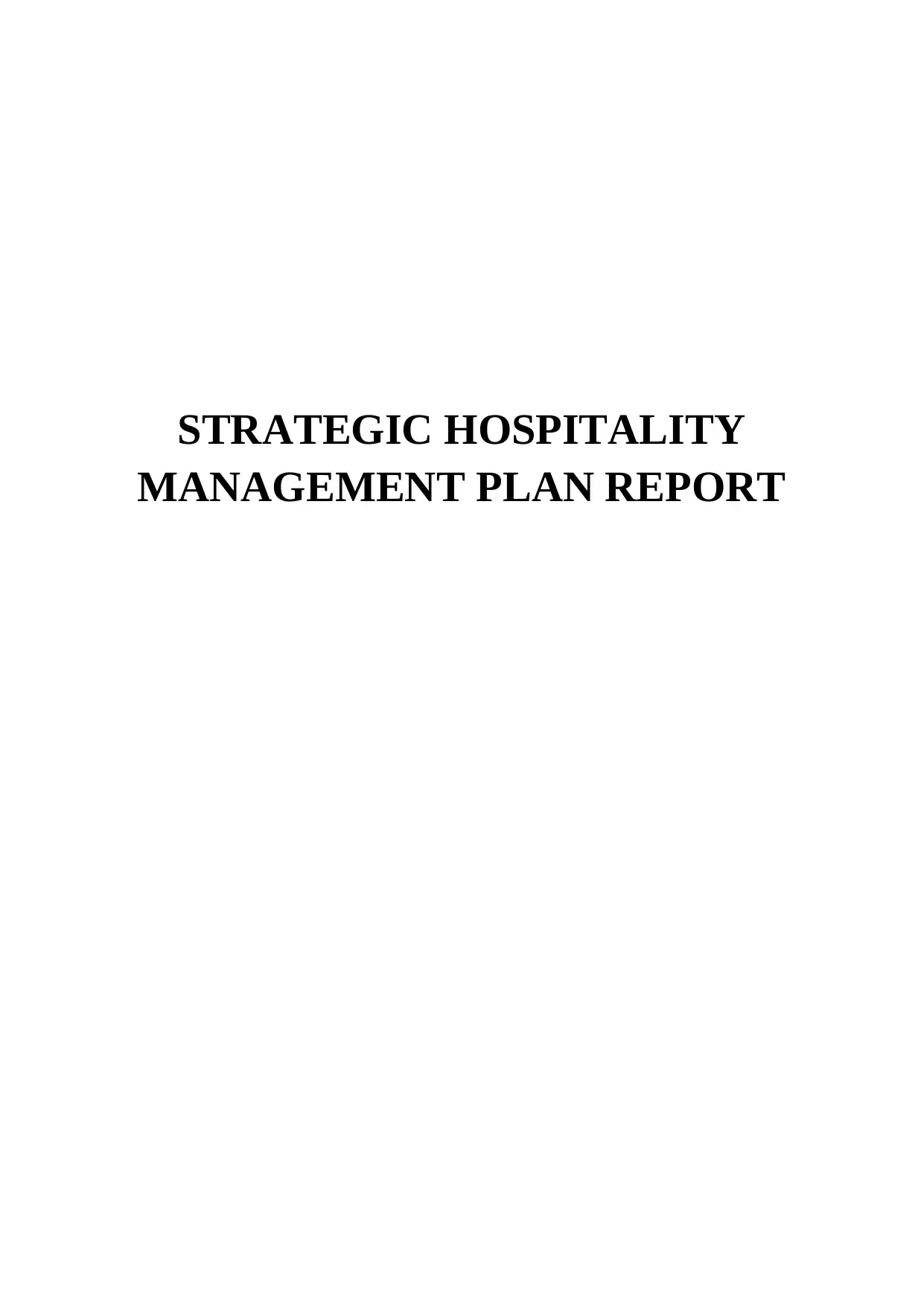
STRATEGIC HOSPITALITY
MANAGEMENT PLAN REPORT
MANAGEMENT PLAN REPORT
Paraphrase This Document
Need a fresh take? Get an instant paraphrase of this document with our AI Paraphraser
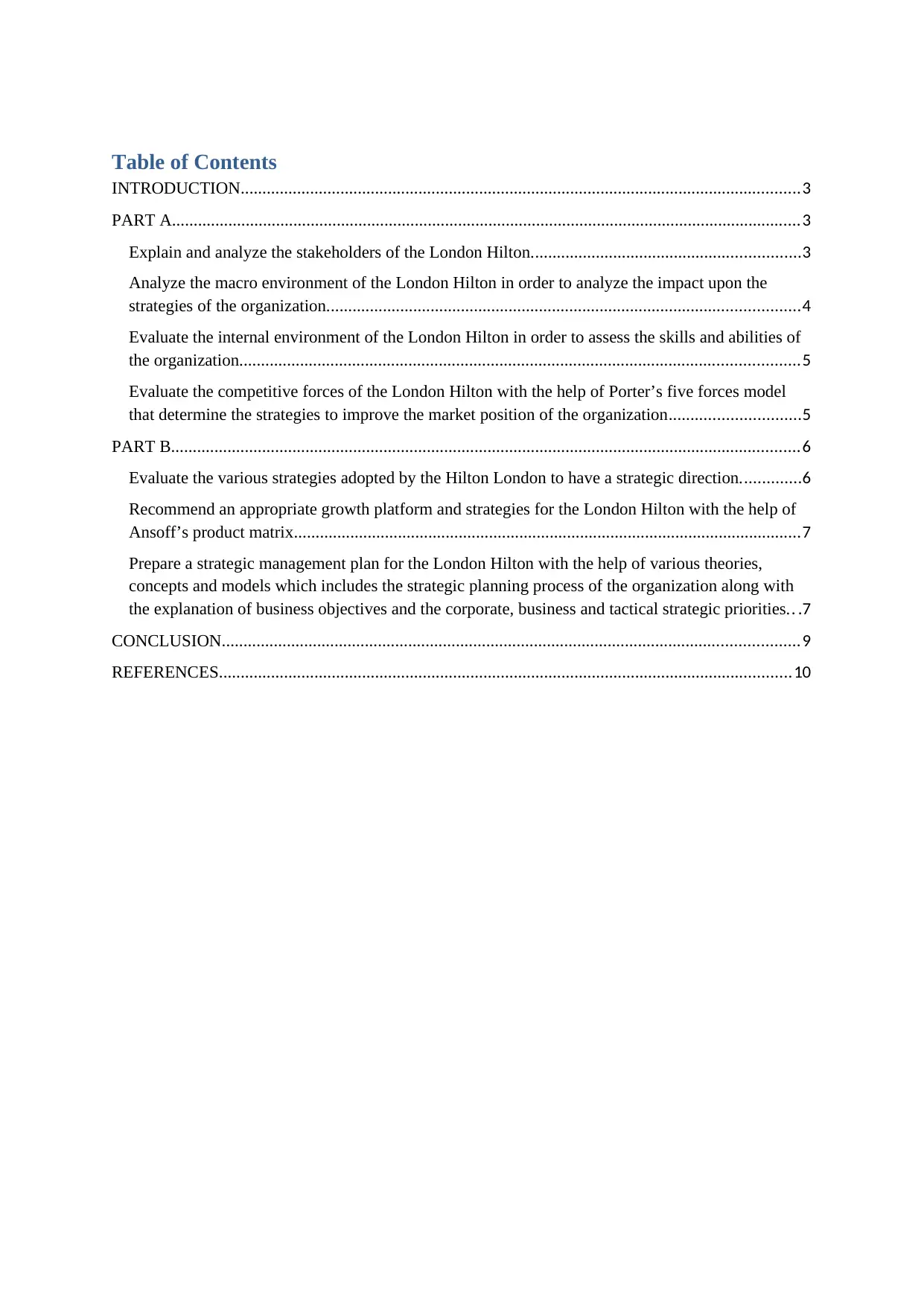
Table of Contents
INTRODUCTION.................................................................................................................................3
PART A.................................................................................................................................................3
Explain and analyze the stakeholders of the London Hilton..............................................................3
Analyze the macro environment of the London Hilton in order to analyze the impact upon the
strategies of the organization.............................................................................................................4
Evaluate the internal environment of the London Hilton in order to assess the skills and abilities of
the organization.................................................................................................................................5
Evaluate the competitive forces of the London Hilton with the help of Porter’s five forces model
that determine the strategies to improve the market position of the organization..............................5
PART B.................................................................................................................................................6
Evaluate the various strategies adopted by the Hilton London to have a strategic direction..............6
Recommend an appropriate growth platform and strategies for the London Hilton with the help of
Ansoff’s product matrix.....................................................................................................................7
Prepare a strategic management plan for the London Hilton with the help of various theories,
concepts and models which includes the strategic planning process of the organization along with
the explanation of business objectives and the corporate, business and tactical strategic priorities.. .7
CONCLUSION.....................................................................................................................................9
REFERENCES....................................................................................................................................10
INTRODUCTION.................................................................................................................................3
PART A.................................................................................................................................................3
Explain and analyze the stakeholders of the London Hilton..............................................................3
Analyze the macro environment of the London Hilton in order to analyze the impact upon the
strategies of the organization.............................................................................................................4
Evaluate the internal environment of the London Hilton in order to assess the skills and abilities of
the organization.................................................................................................................................5
Evaluate the competitive forces of the London Hilton with the help of Porter’s five forces model
that determine the strategies to improve the market position of the organization..............................5
PART B.................................................................................................................................................6
Evaluate the various strategies adopted by the Hilton London to have a strategic direction..............6
Recommend an appropriate growth platform and strategies for the London Hilton with the help of
Ansoff’s product matrix.....................................................................................................................7
Prepare a strategic management plan for the London Hilton with the help of various theories,
concepts and models which includes the strategic planning process of the organization along with
the explanation of business objectives and the corporate, business and tactical strategic priorities.. .7
CONCLUSION.....................................................................................................................................9
REFERENCES....................................................................................................................................10
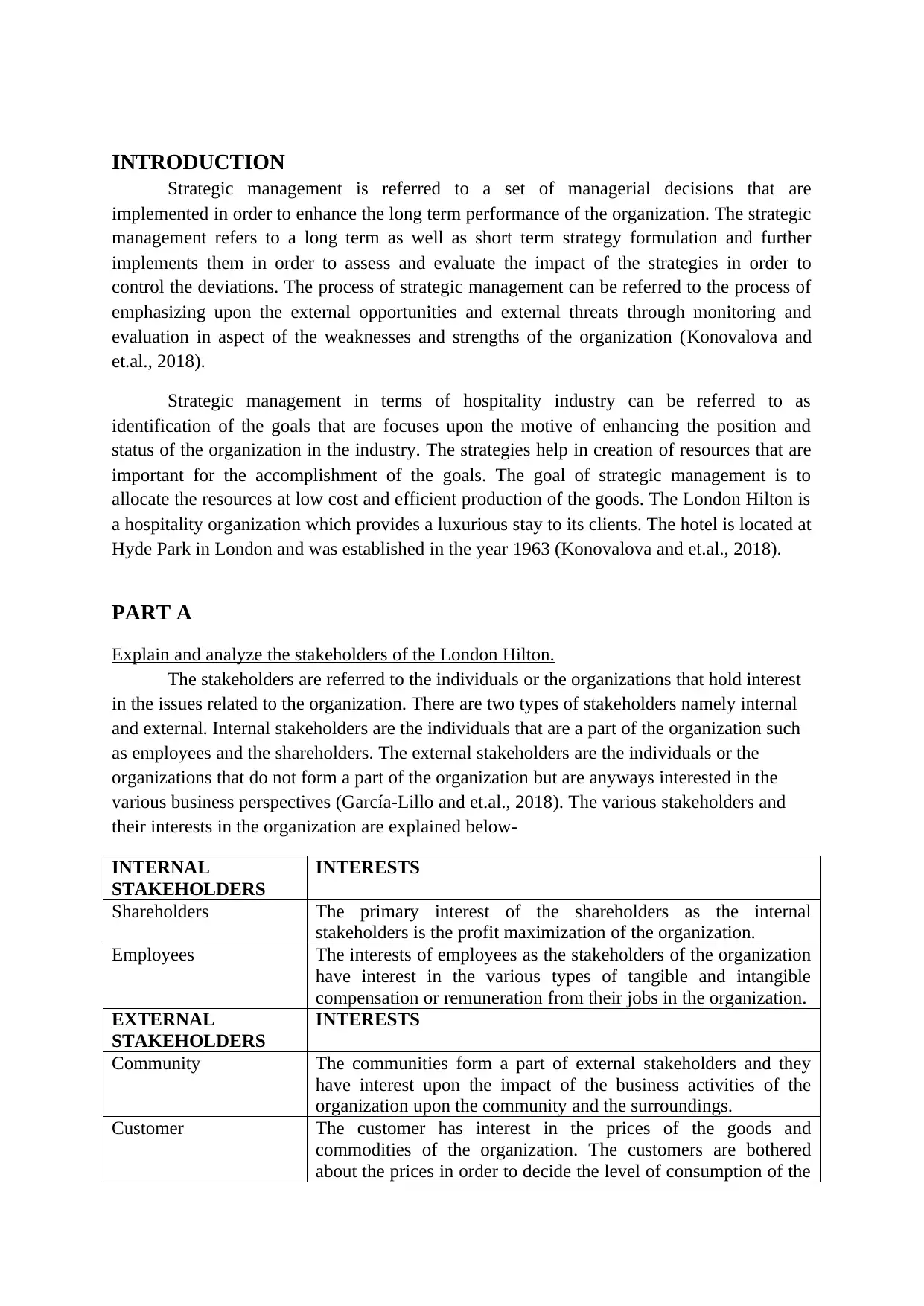
INTRODUCTION
Strategic management is referred to a set of managerial decisions that are
implemented in order to enhance the long term performance of the organization. The strategic
management refers to a long term as well as short term strategy formulation and further
implements them in order to assess and evaluate the impact of the strategies in order to
control the deviations. The process of strategic management can be referred to the process of
emphasizing upon the external opportunities and external threats through monitoring and
evaluation in aspect of the weaknesses and strengths of the organization (Konovalova and
et.al., 2018).
Strategic management in terms of hospitality industry can be referred to as
identification of the goals that are focuses upon the motive of enhancing the position and
status of the organization in the industry. The strategies help in creation of resources that are
important for the accomplishment of the goals. The goal of strategic management is to
allocate the resources at low cost and efficient production of the goods. The London Hilton is
a hospitality organization which provides a luxurious stay to its clients. The hotel is located at
Hyde Park in London and was established in the year 1963 (Konovalova and et.al., 2018).
PART A
Explain and analyze the stakeholders of the London Hilton.
The stakeholders are referred to the individuals or the organizations that hold interest
in the issues related to the organization. There are two types of stakeholders namely internal
and external. Internal stakeholders are the individuals that are a part of the organization such
as employees and the shareholders. The external stakeholders are the individuals or the
organizations that do not form a part of the organization but are anyways interested in the
various business perspectives (García-Lillo and et.al., 2018). The various stakeholders and
their interests in the organization are explained below-
INTERNAL
STAKEHOLDERS
INTERESTS
Shareholders The primary interest of the shareholders as the internal
stakeholders is the profit maximization of the organization.
Employees The interests of employees as the stakeholders of the organization
have interest in the various types of tangible and intangible
compensation or remuneration from their jobs in the organization.
EXTERNAL
STAKEHOLDERS
INTERESTS
Community The communities form a part of external stakeholders and they
have interest upon the impact of the business activities of the
organization upon the community and the surroundings.
Customer The customer has interest in the prices of the goods and
commodities of the organization. The customers are bothered
about the prices in order to decide the level of consumption of the
Strategic management is referred to a set of managerial decisions that are
implemented in order to enhance the long term performance of the organization. The strategic
management refers to a long term as well as short term strategy formulation and further
implements them in order to assess and evaluate the impact of the strategies in order to
control the deviations. The process of strategic management can be referred to the process of
emphasizing upon the external opportunities and external threats through monitoring and
evaluation in aspect of the weaknesses and strengths of the organization (Konovalova and
et.al., 2018).
Strategic management in terms of hospitality industry can be referred to as
identification of the goals that are focuses upon the motive of enhancing the position and
status of the organization in the industry. The strategies help in creation of resources that are
important for the accomplishment of the goals. The goal of strategic management is to
allocate the resources at low cost and efficient production of the goods. The London Hilton is
a hospitality organization which provides a luxurious stay to its clients. The hotel is located at
Hyde Park in London and was established in the year 1963 (Konovalova and et.al., 2018).
PART A
Explain and analyze the stakeholders of the London Hilton.
The stakeholders are referred to the individuals or the organizations that hold interest
in the issues related to the organization. There are two types of stakeholders namely internal
and external. Internal stakeholders are the individuals that are a part of the organization such
as employees and the shareholders. The external stakeholders are the individuals or the
organizations that do not form a part of the organization but are anyways interested in the
various business perspectives (García-Lillo and et.al., 2018). The various stakeholders and
their interests in the organization are explained below-
INTERNAL
STAKEHOLDERS
INTERESTS
Shareholders The primary interest of the shareholders as the internal
stakeholders is the profit maximization of the organization.
Employees The interests of employees as the stakeholders of the organization
have interest in the various types of tangible and intangible
compensation or remuneration from their jobs in the organization.
EXTERNAL
STAKEHOLDERS
INTERESTS
Community The communities form a part of external stakeholders and they
have interest upon the impact of the business activities of the
organization upon the community and the surroundings.
Customer The customer has interest in the prices of the goods and
commodities of the organization. The customers are bothered
about the prices in order to decide the level of consumption of the
You're viewing a preview
Unlock full access by subscribing today!
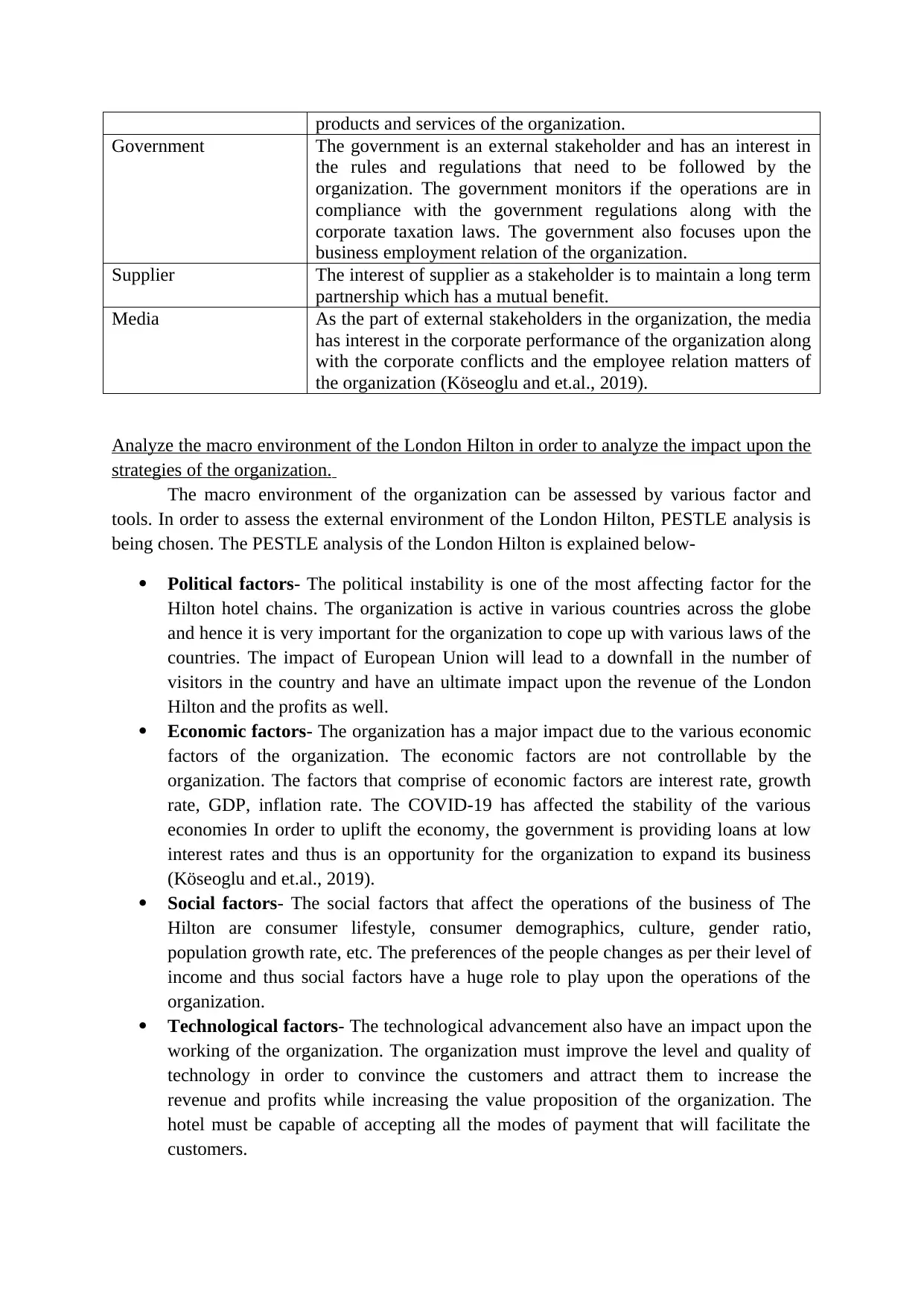
products and services of the organization.
Government The government is an external stakeholder and has an interest in
the rules and regulations that need to be followed by the
organization. The government monitors if the operations are in
compliance with the government regulations along with the
corporate taxation laws. The government also focuses upon the
business employment relation of the organization.
Supplier The interest of supplier as a stakeholder is to maintain a long term
partnership which has a mutual benefit.
Media As the part of external stakeholders in the organization, the media
has interest in the corporate performance of the organization along
with the corporate conflicts and the employee relation matters of
the organization (Köseoglu and et.al., 2019).
Analyze the macro environment of the London Hilton in order to analyze the impact upon the
strategies of the organization.
The macro environment of the organization can be assessed by various factor and
tools. In order to assess the external environment of the London Hilton, PESTLE analysis is
being chosen. The PESTLE analysis of the London Hilton is explained below-
Political factors- The political instability is one of the most affecting factor for the
Hilton hotel chains. The organization is active in various countries across the globe
and hence it is very important for the organization to cope up with various laws of the
countries. The impact of European Union will lead to a downfall in the number of
visitors in the country and have an ultimate impact upon the revenue of the London
Hilton and the profits as well.
Economic factors- The organization has a major impact due to the various economic
factors of the organization. The economic factors are not controllable by the
organization. The factors that comprise of economic factors are interest rate, growth
rate, GDP, inflation rate. The COVID-19 has affected the stability of the various
economies In order to uplift the economy, the government is providing loans at low
interest rates and thus is an opportunity for the organization to expand its business
(Köseoglu and et.al., 2019).
Social factors- The social factors that affect the operations of the business of The
Hilton are consumer lifestyle, consumer demographics, culture, gender ratio,
population growth rate, etc. The preferences of the people changes as per their level of
income and thus social factors have a huge role to play upon the operations of the
organization.
Technological factors- The technological advancement also have an impact upon the
working of the organization. The organization must improve the level and quality of
technology in order to convince the customers and attract them to increase the
revenue and profits while increasing the value proposition of the organization. The
hotel must be capable of accepting all the modes of payment that will facilitate the
customers.
Government The government is an external stakeholder and has an interest in
the rules and regulations that need to be followed by the
organization. The government monitors if the operations are in
compliance with the government regulations along with the
corporate taxation laws. The government also focuses upon the
business employment relation of the organization.
Supplier The interest of supplier as a stakeholder is to maintain a long term
partnership which has a mutual benefit.
Media As the part of external stakeholders in the organization, the media
has interest in the corporate performance of the organization along
with the corporate conflicts and the employee relation matters of
the organization (Köseoglu and et.al., 2019).
Analyze the macro environment of the London Hilton in order to analyze the impact upon the
strategies of the organization.
The macro environment of the organization can be assessed by various factor and
tools. In order to assess the external environment of the London Hilton, PESTLE analysis is
being chosen. The PESTLE analysis of the London Hilton is explained below-
Political factors- The political instability is one of the most affecting factor for the
Hilton hotel chains. The organization is active in various countries across the globe
and hence it is very important for the organization to cope up with various laws of the
countries. The impact of European Union will lead to a downfall in the number of
visitors in the country and have an ultimate impact upon the revenue of the London
Hilton and the profits as well.
Economic factors- The organization has a major impact due to the various economic
factors of the organization. The economic factors are not controllable by the
organization. The factors that comprise of economic factors are interest rate, growth
rate, GDP, inflation rate. The COVID-19 has affected the stability of the various
economies In order to uplift the economy, the government is providing loans at low
interest rates and thus is an opportunity for the organization to expand its business
(Köseoglu and et.al., 2019).
Social factors- The social factors that affect the operations of the business of The
Hilton are consumer lifestyle, consumer demographics, culture, gender ratio,
population growth rate, etc. The preferences of the people changes as per their level of
income and thus social factors have a huge role to play upon the operations of the
organization.
Technological factors- The technological advancement also have an impact upon the
working of the organization. The organization must improve the level and quality of
technology in order to convince the customers and attract them to increase the
revenue and profits while increasing the value proposition of the organization. The
hotel must be capable of accepting all the modes of payment that will facilitate the
customers.
Paraphrase This Document
Need a fresh take? Get an instant paraphrase of this document with our AI Paraphraser
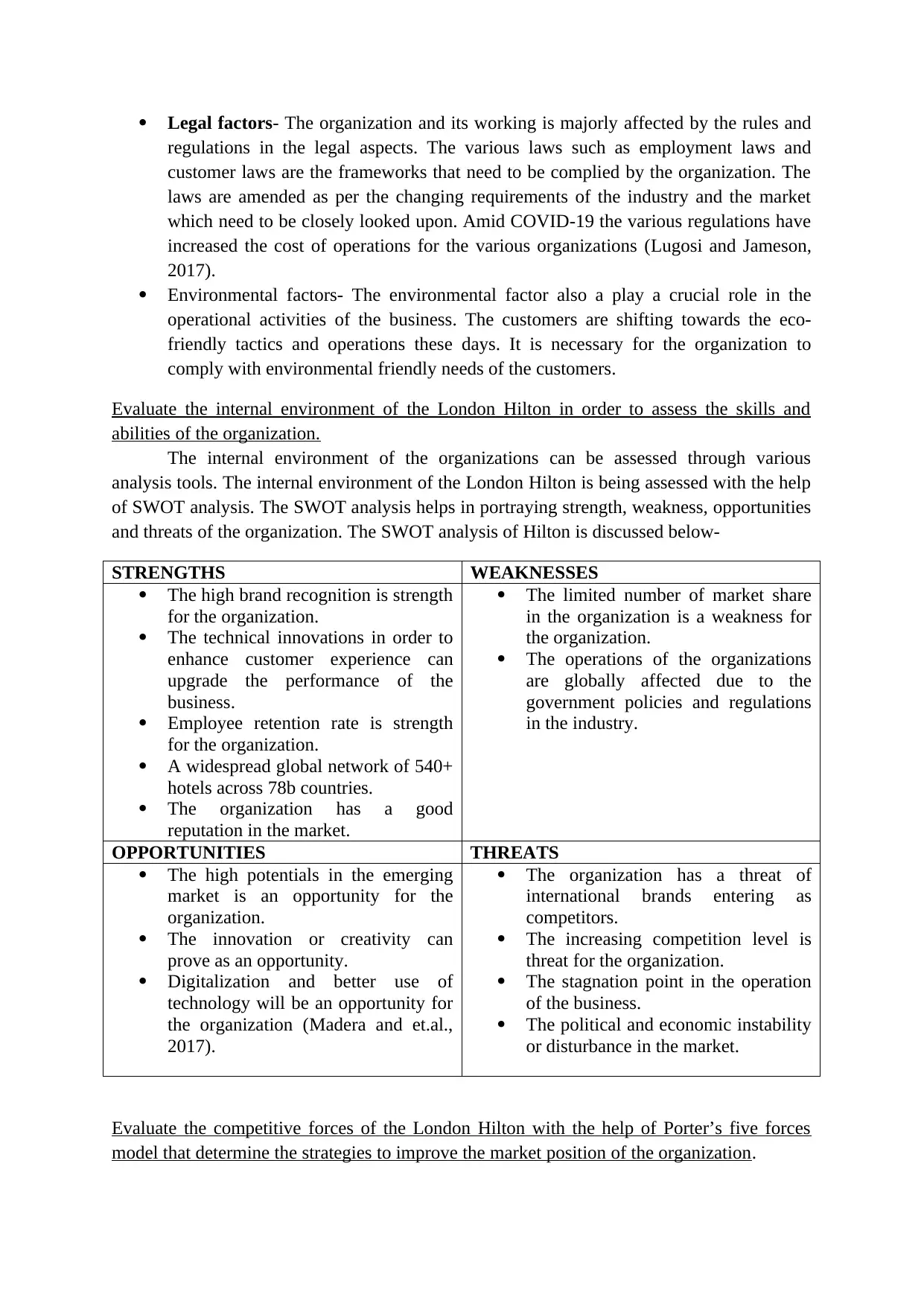
Legal factors- The organization and its working is majorly affected by the rules and
regulations in the legal aspects. The various laws such as employment laws and
customer laws are the frameworks that need to be complied by the organization. The
laws are amended as per the changing requirements of the industry and the market
which need to be closely looked upon. Amid COVID-19 the various regulations have
increased the cost of operations for the various organizations (Lugosi and Jameson,
2017).
Environmental factors- The environmental factor also a play a crucial role in the
operational activities of the business. The customers are shifting towards the eco-
friendly tactics and operations these days. It is necessary for the organization to
comply with environmental friendly needs of the customers.
Evaluate the internal environment of the London Hilton in order to assess the skills and
abilities of the organization.
The internal environment of the organizations can be assessed through various
analysis tools. The internal environment of the London Hilton is being assessed with the help
of SWOT analysis. The SWOT analysis helps in portraying strength, weakness, opportunities
and threats of the organization. The SWOT analysis of Hilton is discussed below-
STRENGTHS WEAKNESSES
The high brand recognition is strength
for the organization.
The technical innovations in order to
enhance customer experience can
upgrade the performance of the
business.
Employee retention rate is strength
for the organization.
A widespread global network of 540+
hotels across 78b countries.
The organization has a good
reputation in the market.
The limited number of market share
in the organization is a weakness for
the organization.
The operations of the organizations
are globally affected due to the
government policies and regulations
in the industry.
OPPORTUNITIES THREATS
The high potentials in the emerging
market is an opportunity for the
organization.
The innovation or creativity can
prove as an opportunity.
Digitalization and better use of
technology will be an opportunity for
the organization (Madera and et.al.,
2017).
The organization has a threat of
international brands entering as
competitors.
The increasing competition level is
threat for the organization.
The stagnation point in the operation
of the business.
The political and economic instability
or disturbance in the market.
Evaluate the competitive forces of the London Hilton with the help of Porter’s five forces
model that determine the strategies to improve the market position of the organization.
regulations in the legal aspects. The various laws such as employment laws and
customer laws are the frameworks that need to be complied by the organization. The
laws are amended as per the changing requirements of the industry and the market
which need to be closely looked upon. Amid COVID-19 the various regulations have
increased the cost of operations for the various organizations (Lugosi and Jameson,
2017).
Environmental factors- The environmental factor also a play a crucial role in the
operational activities of the business. The customers are shifting towards the eco-
friendly tactics and operations these days. It is necessary for the organization to
comply with environmental friendly needs of the customers.
Evaluate the internal environment of the London Hilton in order to assess the skills and
abilities of the organization.
The internal environment of the organizations can be assessed through various
analysis tools. The internal environment of the London Hilton is being assessed with the help
of SWOT analysis. The SWOT analysis helps in portraying strength, weakness, opportunities
and threats of the organization. The SWOT analysis of Hilton is discussed below-
STRENGTHS WEAKNESSES
The high brand recognition is strength
for the organization.
The technical innovations in order to
enhance customer experience can
upgrade the performance of the
business.
Employee retention rate is strength
for the organization.
A widespread global network of 540+
hotels across 78b countries.
The organization has a good
reputation in the market.
The limited number of market share
in the organization is a weakness for
the organization.
The operations of the organizations
are globally affected due to the
government policies and regulations
in the industry.
OPPORTUNITIES THREATS
The high potentials in the emerging
market is an opportunity for the
organization.
The innovation or creativity can
prove as an opportunity.
Digitalization and better use of
technology will be an opportunity for
the organization (Madera and et.al.,
2017).
The organization has a threat of
international brands entering as
competitors.
The increasing competition level is
threat for the organization.
The stagnation point in the operation
of the business.
The political and economic instability
or disturbance in the market.
Evaluate the competitive forces of the London Hilton with the help of Porter’s five forces
model that determine the strategies to improve the market position of the organization.
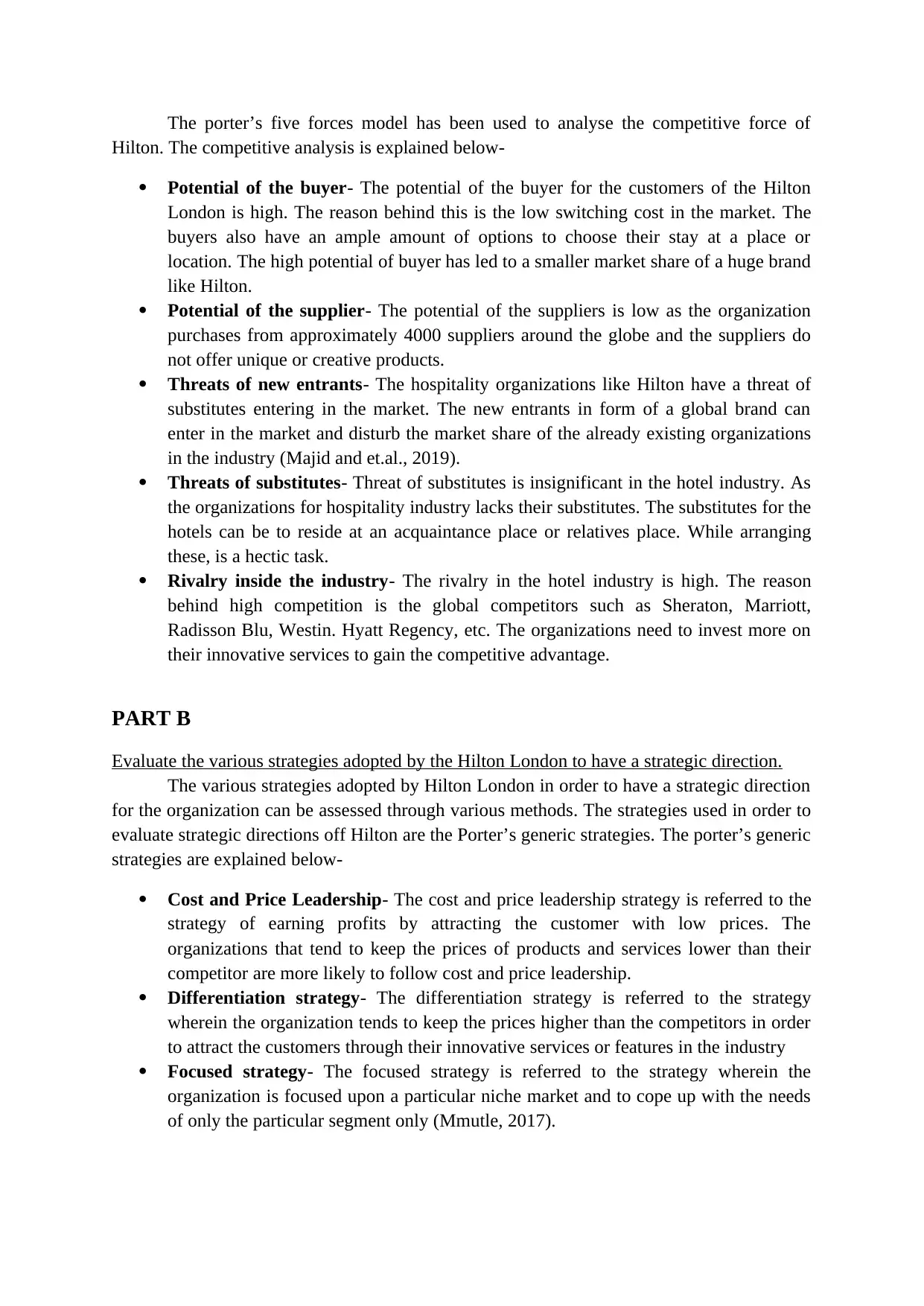
The porter’s five forces model has been used to analyse the competitive force of
Hilton. The competitive analysis is explained below-
Potential of the buyer- The potential of the buyer for the customers of the Hilton
London is high. The reason behind this is the low switching cost in the market. The
buyers also have an ample amount of options to choose their stay at a place or
location. The high potential of buyer has led to a smaller market share of a huge brand
like Hilton.
Potential of the supplier- The potential of the suppliers is low as the organization
purchases from approximately 4000 suppliers around the globe and the suppliers do
not offer unique or creative products.
Threats of new entrants- The hospitality organizations like Hilton have a threat of
substitutes entering in the market. The new entrants in form of a global brand can
enter in the market and disturb the market share of the already existing organizations
in the industry (Majid and et.al., 2019).
Threats of substitutes- Threat of substitutes is insignificant in the hotel industry. As
the organizations for hospitality industry lacks their substitutes. The substitutes for the
hotels can be to reside at an acquaintance place or relatives place. While arranging
these, is a hectic task.
Rivalry inside the industry- The rivalry in the hotel industry is high. The reason
behind high competition is the global competitors such as Sheraton, Marriott,
Radisson Blu, Westin. Hyatt Regency, etc. The organizations need to invest more on
their innovative services to gain the competitive advantage.
PART B
Evaluate the various strategies adopted by the Hilton London to have a strategic direction.
The various strategies adopted by Hilton London in order to have a strategic direction
for the organization can be assessed through various methods. The strategies used in order to
evaluate strategic directions off Hilton are the Porter’s generic strategies. The porter’s generic
strategies are explained below-
Cost and Price Leadership- The cost and price leadership strategy is referred to the
strategy of earning profits by attracting the customer with low prices. The
organizations that tend to keep the prices of products and services lower than their
competitor are more likely to follow cost and price leadership.
Differentiation strategy- The differentiation strategy is referred to the strategy
wherein the organization tends to keep the prices higher than the competitors in order
to attract the customers through their innovative services or features in the industry
Focused strategy- The focused strategy is referred to the strategy wherein the
organization is focused upon a particular niche market and to cope up with the needs
of only the particular segment only (Mmutle, 2017).
Hilton. The competitive analysis is explained below-
Potential of the buyer- The potential of the buyer for the customers of the Hilton
London is high. The reason behind this is the low switching cost in the market. The
buyers also have an ample amount of options to choose their stay at a place or
location. The high potential of buyer has led to a smaller market share of a huge brand
like Hilton.
Potential of the supplier- The potential of the suppliers is low as the organization
purchases from approximately 4000 suppliers around the globe and the suppliers do
not offer unique or creative products.
Threats of new entrants- The hospitality organizations like Hilton have a threat of
substitutes entering in the market. The new entrants in form of a global brand can
enter in the market and disturb the market share of the already existing organizations
in the industry (Majid and et.al., 2019).
Threats of substitutes- Threat of substitutes is insignificant in the hotel industry. As
the organizations for hospitality industry lacks their substitutes. The substitutes for the
hotels can be to reside at an acquaintance place or relatives place. While arranging
these, is a hectic task.
Rivalry inside the industry- The rivalry in the hotel industry is high. The reason
behind high competition is the global competitors such as Sheraton, Marriott,
Radisson Blu, Westin. Hyatt Regency, etc. The organizations need to invest more on
their innovative services to gain the competitive advantage.
PART B
Evaluate the various strategies adopted by the Hilton London to have a strategic direction.
The various strategies adopted by Hilton London in order to have a strategic direction
for the organization can be assessed through various methods. The strategies used in order to
evaluate strategic directions off Hilton are the Porter’s generic strategies. The porter’s generic
strategies are explained below-
Cost and Price Leadership- The cost and price leadership strategy is referred to the
strategy of earning profits by attracting the customer with low prices. The
organizations that tend to keep the prices of products and services lower than their
competitor are more likely to follow cost and price leadership.
Differentiation strategy- The differentiation strategy is referred to the strategy
wherein the organization tends to keep the prices higher than the competitors in order
to attract the customers through their innovative services or features in the industry
Focused strategy- The focused strategy is referred to the strategy wherein the
organization is focused upon a particular niche market and to cope up with the needs
of only the particular segment only (Mmutle, 2017).
You're viewing a preview
Unlock full access by subscribing today!
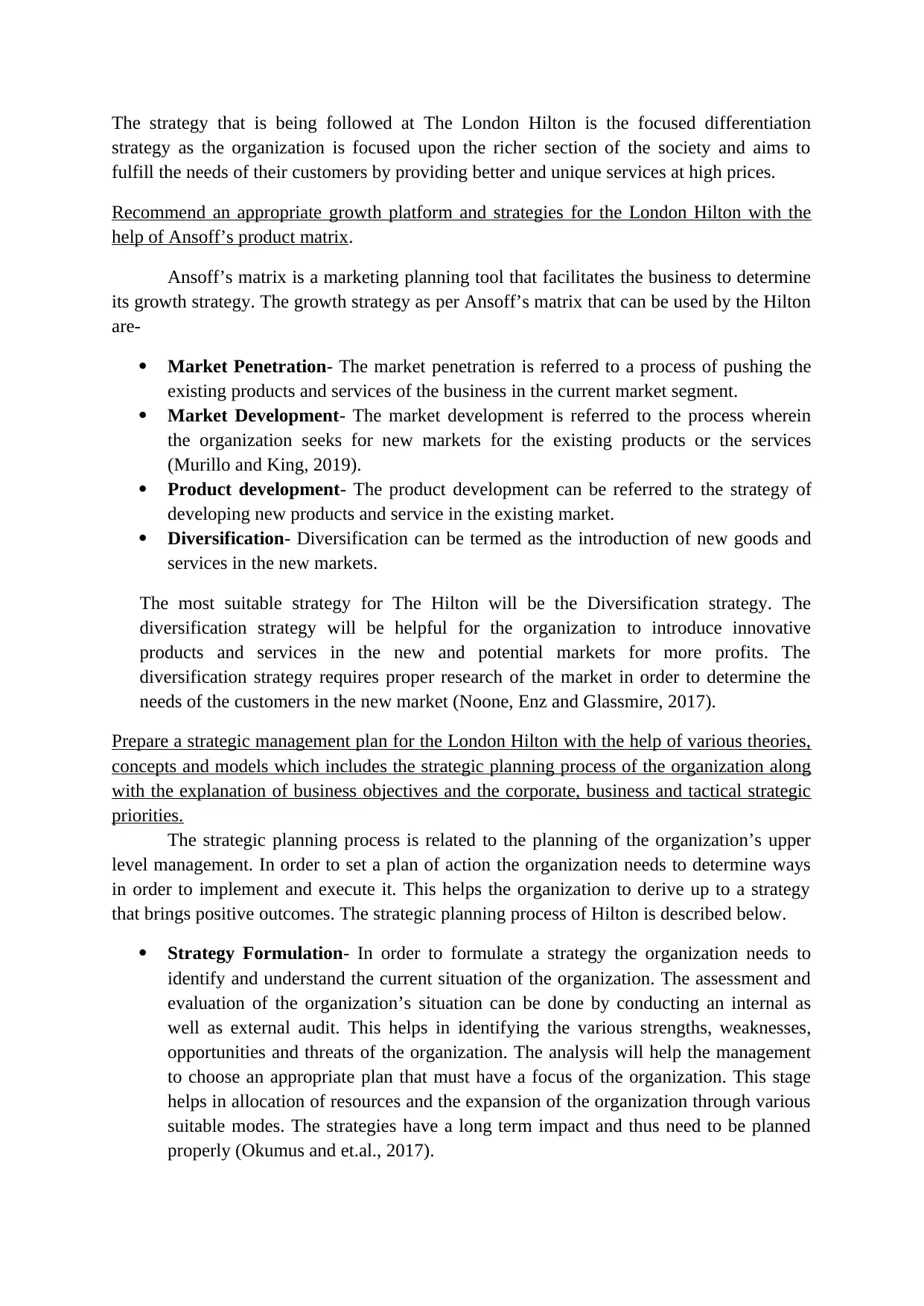
The strategy that is being followed at The London Hilton is the focused differentiation
strategy as the organization is focused upon the richer section of the society and aims to
fulfill the needs of their customers by providing better and unique services at high prices.
Recommend an appropriate growth platform and strategies for the London Hilton with the
help of Ansoff’s product matrix.
Ansoff’s matrix is a marketing planning tool that facilitates the business to determine
its growth strategy. The growth strategy as per Ansoff’s matrix that can be used by the Hilton
are-
Market Penetration- The market penetration is referred to a process of pushing the
existing products and services of the business in the current market segment.
Market Development- The market development is referred to the process wherein
the organization seeks for new markets for the existing products or the services
(Murillo and King, 2019).
Product development- The product development can be referred to the strategy of
developing new products and service in the existing market.
Diversification- Diversification can be termed as the introduction of new goods and
services in the new markets.
The most suitable strategy for The Hilton will be the Diversification strategy. The
diversification strategy will be helpful for the organization to introduce innovative
products and services in the new and potential markets for more profits. The
diversification strategy requires proper research of the market in order to determine the
needs of the customers in the new market (Noone, Enz and Glassmire, 2017).
Prepare a strategic management plan for the London Hilton with the help of various theories,
concepts and models which includes the strategic planning process of the organization along
with the explanation of business objectives and the corporate, business and tactical strategic
priorities.
The strategic planning process is related to the planning of the organization’s upper
level management. In order to set a plan of action the organization needs to determine ways
in order to implement and execute it. This helps the organization to derive up to a strategy
that brings positive outcomes. The strategic planning process of Hilton is described below.
Strategy Formulation- In order to formulate a strategy the organization needs to
identify and understand the current situation of the organization. The assessment and
evaluation of the organization’s situation can be done by conducting an internal as
well as external audit. This helps in identifying the various strengths, weaknesses,
opportunities and threats of the organization. The analysis will help the management
to choose an appropriate plan that must have a focus of the organization. This stage
helps in allocation of resources and the expansion of the organization through various
suitable modes. The strategies have a long term impact and thus need to be planned
properly (Okumus and et.al., 2017).
strategy as the organization is focused upon the richer section of the society and aims to
fulfill the needs of their customers by providing better and unique services at high prices.
Recommend an appropriate growth platform and strategies for the London Hilton with the
help of Ansoff’s product matrix.
Ansoff’s matrix is a marketing planning tool that facilitates the business to determine
its growth strategy. The growth strategy as per Ansoff’s matrix that can be used by the Hilton
are-
Market Penetration- The market penetration is referred to a process of pushing the
existing products and services of the business in the current market segment.
Market Development- The market development is referred to the process wherein
the organization seeks for new markets for the existing products or the services
(Murillo and King, 2019).
Product development- The product development can be referred to the strategy of
developing new products and service in the existing market.
Diversification- Diversification can be termed as the introduction of new goods and
services in the new markets.
The most suitable strategy for The Hilton will be the Diversification strategy. The
diversification strategy will be helpful for the organization to introduce innovative
products and services in the new and potential markets for more profits. The
diversification strategy requires proper research of the market in order to determine the
needs of the customers in the new market (Noone, Enz and Glassmire, 2017).
Prepare a strategic management plan for the London Hilton with the help of various theories,
concepts and models which includes the strategic planning process of the organization along
with the explanation of business objectives and the corporate, business and tactical strategic
priorities.
The strategic planning process is related to the planning of the organization’s upper
level management. In order to set a plan of action the organization needs to determine ways
in order to implement and execute it. This helps the organization to derive up to a strategy
that brings positive outcomes. The strategic planning process of Hilton is described below.
Strategy Formulation- In order to formulate a strategy the organization needs to
identify and understand the current situation of the organization. The assessment and
evaluation of the organization’s situation can be done by conducting an internal as
well as external audit. This helps in identifying the various strengths, weaknesses,
opportunities and threats of the organization. The analysis will help the management
to choose an appropriate plan that must have a focus of the organization. This stage
helps in allocation of resources and the expansion of the organization through various
suitable modes. The strategies have a long term impact and thus need to be planned
properly (Okumus and et.al., 2017).
Paraphrase This Document
Need a fresh take? Get an instant paraphrase of this document with our AI Paraphraser
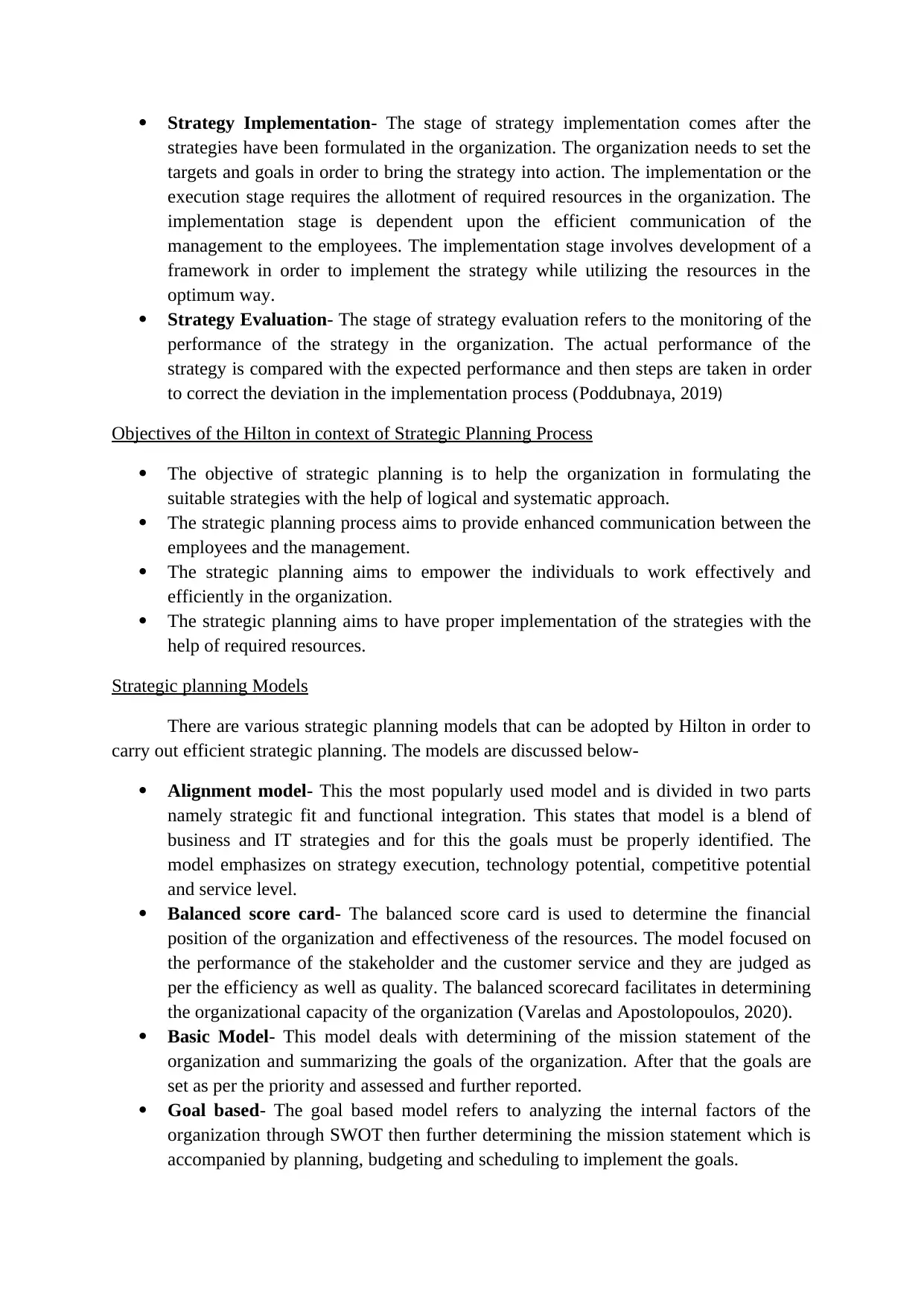
Strategy Implementation- The stage of strategy implementation comes after the
strategies have been formulated in the organization. The organization needs to set the
targets and goals in order to bring the strategy into action. The implementation or the
execution stage requires the allotment of required resources in the organization. The
implementation stage is dependent upon the efficient communication of the
management to the employees. The implementation stage involves development of a
framework in order to implement the strategy while utilizing the resources in the
optimum way.
Strategy Evaluation- The stage of strategy evaluation refers to the monitoring of the
performance of the strategy in the organization. The actual performance of the
strategy is compared with the expected performance and then steps are taken in order
to correct the deviation in the implementation process (Poddubnaya, 2019)
Objectives of the Hilton in context of Strategic Planning Process
The objective of strategic planning is to help the organization in formulating the
suitable strategies with the help of logical and systematic approach.
The strategic planning process aims to provide enhanced communication between the
employees and the management.
The strategic planning aims to empower the individuals to work effectively and
efficiently in the organization.
The strategic planning aims to have proper implementation of the strategies with the
help of required resources.
Strategic planning Models
There are various strategic planning models that can be adopted by Hilton in order to
carry out efficient strategic planning. The models are discussed below-
Alignment model- This the most popularly used model and is divided in two parts
namely strategic fit and functional integration. This states that model is a blend of
business and IT strategies and for this the goals must be properly identified. The
model emphasizes on strategy execution, technology potential, competitive potential
and service level.
Balanced score card- The balanced score card is used to determine the financial
position of the organization and effectiveness of the resources. The model focused on
the performance of the stakeholder and the customer service and they are judged as
per the efficiency as well as quality. The balanced scorecard facilitates in determining
the organizational capacity of the organization (Varelas and Apostolopoulos, 2020).
Basic Model- This model deals with determining of the mission statement of the
organization and summarizing the goals of the organization. After that the goals are
set as per the priority and assessed and further reported.
Goal based- The goal based model refers to analyzing the internal factors of the
organization through SWOT then further determining the mission statement which is
accompanied by planning, budgeting and scheduling to implement the goals.
strategies have been formulated in the organization. The organization needs to set the
targets and goals in order to bring the strategy into action. The implementation or the
execution stage requires the allotment of required resources in the organization. The
implementation stage is dependent upon the efficient communication of the
management to the employees. The implementation stage involves development of a
framework in order to implement the strategy while utilizing the resources in the
optimum way.
Strategy Evaluation- The stage of strategy evaluation refers to the monitoring of the
performance of the strategy in the organization. The actual performance of the
strategy is compared with the expected performance and then steps are taken in order
to correct the deviation in the implementation process (Poddubnaya, 2019)
Objectives of the Hilton in context of Strategic Planning Process
The objective of strategic planning is to help the organization in formulating the
suitable strategies with the help of logical and systematic approach.
The strategic planning process aims to provide enhanced communication between the
employees and the management.
The strategic planning aims to empower the individuals to work effectively and
efficiently in the organization.
The strategic planning aims to have proper implementation of the strategies with the
help of required resources.
Strategic planning Models
There are various strategic planning models that can be adopted by Hilton in order to
carry out efficient strategic planning. The models are discussed below-
Alignment model- This the most popularly used model and is divided in two parts
namely strategic fit and functional integration. This states that model is a blend of
business and IT strategies and for this the goals must be properly identified. The
model emphasizes on strategy execution, technology potential, competitive potential
and service level.
Balanced score card- The balanced score card is used to determine the financial
position of the organization and effectiveness of the resources. The model focused on
the performance of the stakeholder and the customer service and they are judged as
per the efficiency as well as quality. The balanced scorecard facilitates in determining
the organizational capacity of the organization (Varelas and Apostolopoulos, 2020).
Basic Model- This model deals with determining of the mission statement of the
organization and summarizing the goals of the organization. After that the goals are
set as per the priority and assessed and further reported.
Goal based- The goal based model refers to analyzing the internal factors of the
organization through SWOT then further determining the mission statement which is
accompanied by planning, budgeting and scheduling to implement the goals.
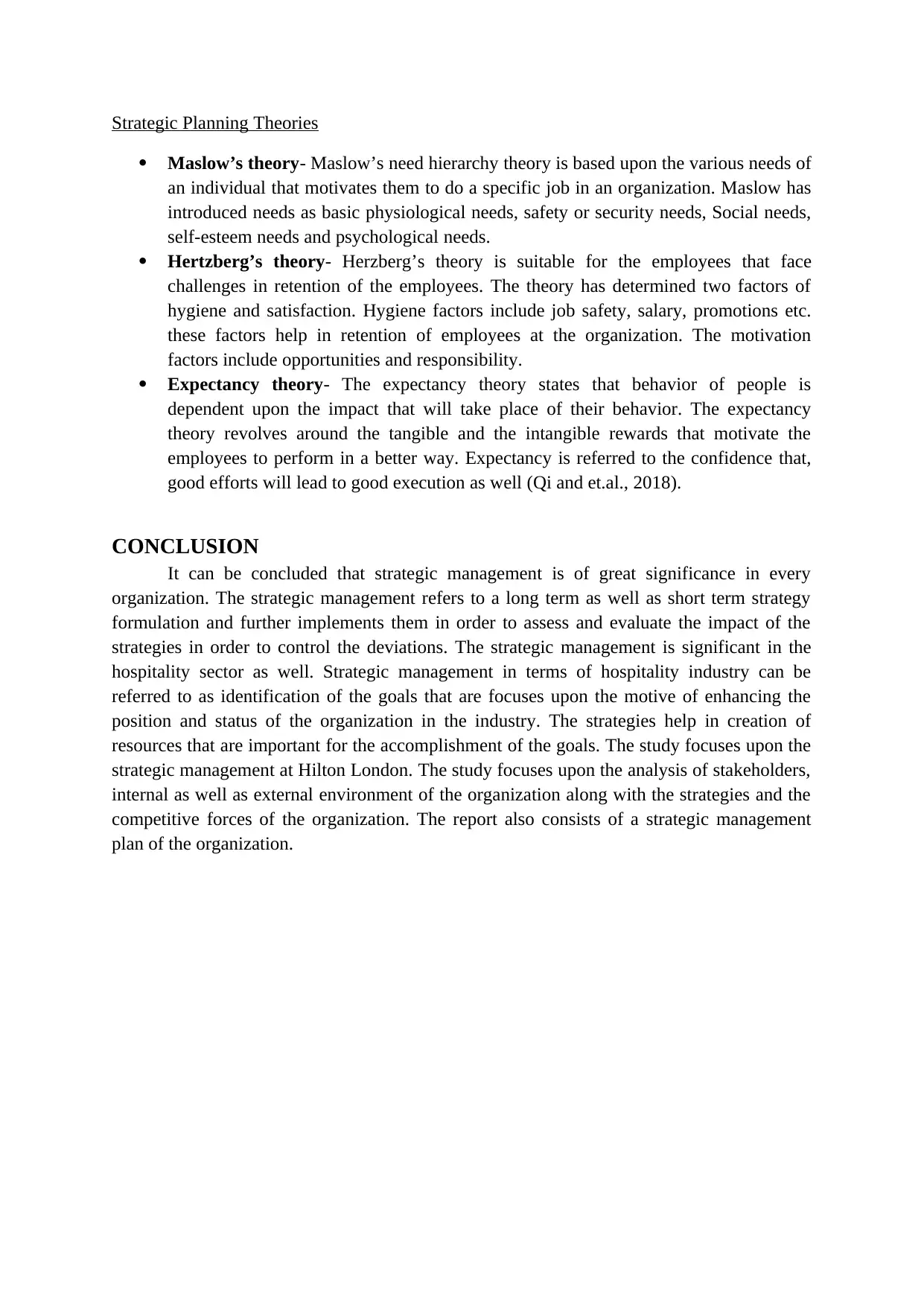
Strategic Planning Theories
Maslow’s theory- Maslow’s need hierarchy theory is based upon the various needs of
an individual that motivates them to do a specific job in an organization. Maslow has
introduced needs as basic physiological needs, safety or security needs, Social needs,
self-esteem needs and psychological needs.
Hertzberg’s theory- Herzberg’s theory is suitable for the employees that face
challenges in retention of the employees. The theory has determined two factors of
hygiene and satisfaction. Hygiene factors include job safety, salary, promotions etc.
these factors help in retention of employees at the organization. The motivation
factors include opportunities and responsibility.
Expectancy theory- The expectancy theory states that behavior of people is
dependent upon the impact that will take place of their behavior. The expectancy
theory revolves around the tangible and the intangible rewards that motivate the
employees to perform in a better way. Expectancy is referred to the confidence that,
good efforts will lead to good execution as well (Qi and et.al., 2018).
CONCLUSION
It can be concluded that strategic management is of great significance in every
organization. The strategic management refers to a long term as well as short term strategy
formulation and further implements them in order to assess and evaluate the impact of the
strategies in order to control the deviations. The strategic management is significant in the
hospitality sector as well. Strategic management in terms of hospitality industry can be
referred to as identification of the goals that are focuses upon the motive of enhancing the
position and status of the organization in the industry. The strategies help in creation of
resources that are important for the accomplishment of the goals. The study focuses upon the
strategic management at Hilton London. The study focuses upon the analysis of stakeholders,
internal as well as external environment of the organization along with the strategies and the
competitive forces of the organization. The report also consists of a strategic management
plan of the organization.
Maslow’s theory- Maslow’s need hierarchy theory is based upon the various needs of
an individual that motivates them to do a specific job in an organization. Maslow has
introduced needs as basic physiological needs, safety or security needs, Social needs,
self-esteem needs and psychological needs.
Hertzberg’s theory- Herzberg’s theory is suitable for the employees that face
challenges in retention of the employees. The theory has determined two factors of
hygiene and satisfaction. Hygiene factors include job safety, salary, promotions etc.
these factors help in retention of employees at the organization. The motivation
factors include opportunities and responsibility.
Expectancy theory- The expectancy theory states that behavior of people is
dependent upon the impact that will take place of their behavior. The expectancy
theory revolves around the tangible and the intangible rewards that motivate the
employees to perform in a better way. Expectancy is referred to the confidence that,
good efforts will lead to good execution as well (Qi and et.al., 2018).
CONCLUSION
It can be concluded that strategic management is of great significance in every
organization. The strategic management refers to a long term as well as short term strategy
formulation and further implements them in order to assess and evaluate the impact of the
strategies in order to control the deviations. The strategic management is significant in the
hospitality sector as well. Strategic management in terms of hospitality industry can be
referred to as identification of the goals that are focuses upon the motive of enhancing the
position and status of the organization in the industry. The strategies help in creation of
resources that are important for the accomplishment of the goals. The study focuses upon the
strategic management at Hilton London. The study focuses upon the analysis of stakeholders,
internal as well as external environment of the organization along with the strategies and the
competitive forces of the organization. The report also consists of a strategic management
plan of the organization.
You're viewing a preview
Unlock full access by subscribing today!
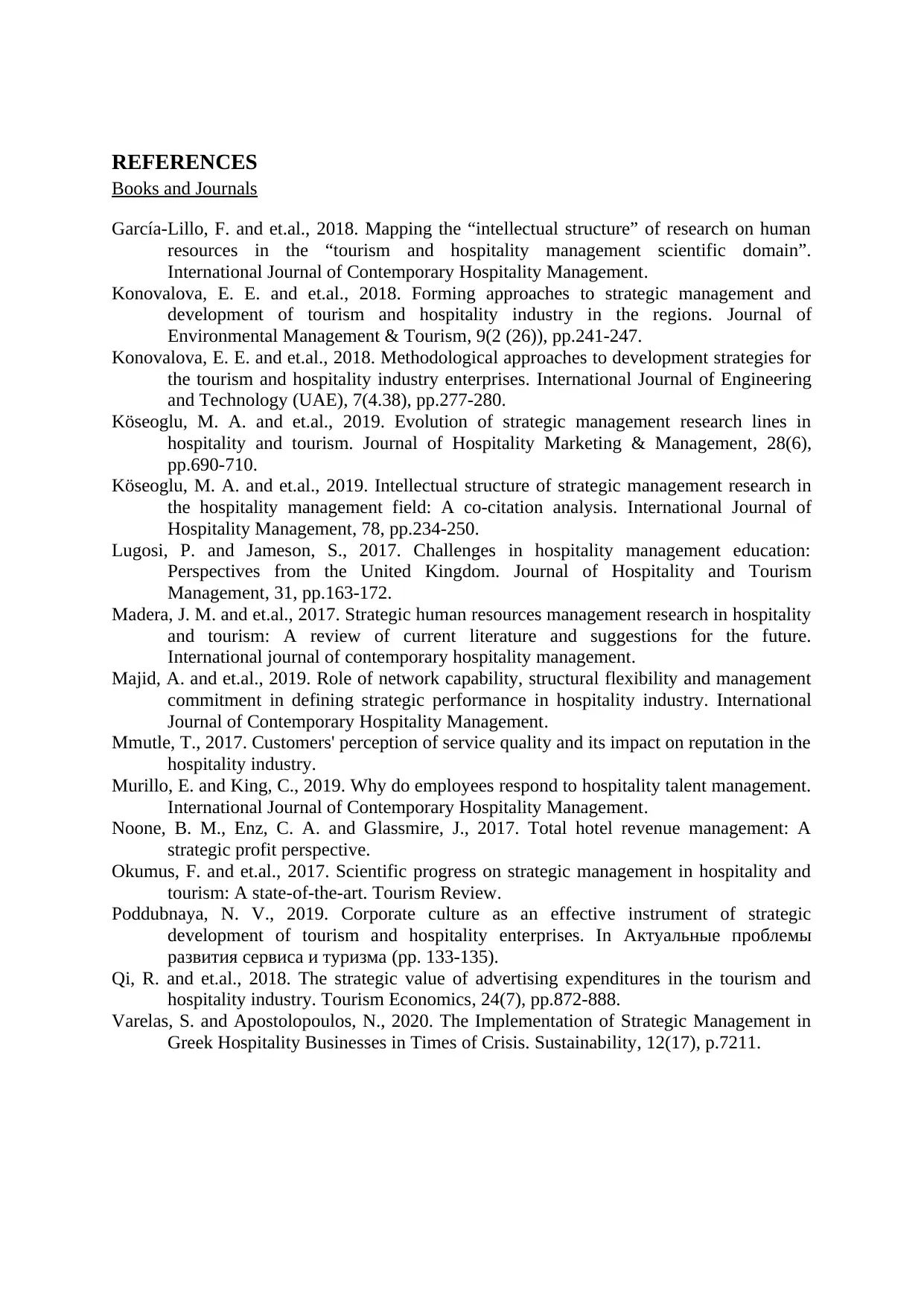
REFERENCES
Books and Journals
García-Lillo, F. and et.al., 2018. Mapping the “intellectual structure” of research on human
resources in the “tourism and hospitality management scientific domain”.
International Journal of Contemporary Hospitality Management.
Konovalova, E. E. and et.al., 2018. Forming approaches to strategic management and
development of tourism and hospitality industry in the regions. Journal of
Environmental Management & Tourism, 9(2 (26)), pp.241-247.
Konovalova, E. E. and et.al., 2018. Methodological approaches to development strategies for
the tourism and hospitality industry enterprises. International Journal of Engineering
and Technology (UAE), 7(4.38), pp.277-280.
Köseoglu, M. A. and et.al., 2019. Evolution of strategic management research lines in
hospitality and tourism. Journal of Hospitality Marketing & Management, 28(6),
pp.690-710.
Köseoglu, M. A. and et.al., 2019. Intellectual structure of strategic management research in
the hospitality management field: A co-citation analysis. International Journal of
Hospitality Management, 78, pp.234-250.
Lugosi, P. and Jameson, S., 2017. Challenges in hospitality management education:
Perspectives from the United Kingdom. Journal of Hospitality and Tourism
Management, 31, pp.163-172.
Madera, J. M. and et.al., 2017. Strategic human resources management research in hospitality
and tourism: A review of current literature and suggestions for the future.
International journal of contemporary hospitality management.
Majid, A. and et.al., 2019. Role of network capability, structural flexibility and management
commitment in defining strategic performance in hospitality industry. International
Journal of Contemporary Hospitality Management.
Mmutle, T., 2017. Customers' perception of service quality and its impact on reputation in the
hospitality industry.
Murillo, E. and King, C., 2019. Why do employees respond to hospitality talent management.
International Journal of Contemporary Hospitality Management.
Noone, B. M., Enz, C. A. and Glassmire, J., 2017. Total hotel revenue management: A
strategic profit perspective.
Okumus, F. and et.al., 2017. Scientific progress on strategic management in hospitality and
tourism: A state-of-the-art. Tourism Review.
Poddubnaya, N. V., 2019. Corporate culture as an effective instrument of strategic
development of tourism and hospitality enterprises. In Актуальные проблемы
развития сервиса и туризма (pp. 133-135).
Qi, R. and et.al., 2018. The strategic value of advertising expenditures in the tourism and
hospitality industry. Tourism Economics, 24(7), pp.872-888.
Varelas, S. and Apostolopoulos, N., 2020. The Implementation of Strategic Management in
Greek Hospitality Businesses in Times of Crisis. Sustainability, 12(17), p.7211.
Books and Journals
García-Lillo, F. and et.al., 2018. Mapping the “intellectual structure” of research on human
resources in the “tourism and hospitality management scientific domain”.
International Journal of Contemporary Hospitality Management.
Konovalova, E. E. and et.al., 2018. Forming approaches to strategic management and
development of tourism and hospitality industry in the regions. Journal of
Environmental Management & Tourism, 9(2 (26)), pp.241-247.
Konovalova, E. E. and et.al., 2018. Methodological approaches to development strategies for
the tourism and hospitality industry enterprises. International Journal of Engineering
and Technology (UAE), 7(4.38), pp.277-280.
Köseoglu, M. A. and et.al., 2019. Evolution of strategic management research lines in
hospitality and tourism. Journal of Hospitality Marketing & Management, 28(6),
pp.690-710.
Köseoglu, M. A. and et.al., 2019. Intellectual structure of strategic management research in
the hospitality management field: A co-citation analysis. International Journal of
Hospitality Management, 78, pp.234-250.
Lugosi, P. and Jameson, S., 2017. Challenges in hospitality management education:
Perspectives from the United Kingdom. Journal of Hospitality and Tourism
Management, 31, pp.163-172.
Madera, J. M. and et.al., 2017. Strategic human resources management research in hospitality
and tourism: A review of current literature and suggestions for the future.
International journal of contemporary hospitality management.
Majid, A. and et.al., 2019. Role of network capability, structural flexibility and management
commitment in defining strategic performance in hospitality industry. International
Journal of Contemporary Hospitality Management.
Mmutle, T., 2017. Customers' perception of service quality and its impact on reputation in the
hospitality industry.
Murillo, E. and King, C., 2019. Why do employees respond to hospitality talent management.
International Journal of Contemporary Hospitality Management.
Noone, B. M., Enz, C. A. and Glassmire, J., 2017. Total hotel revenue management: A
strategic profit perspective.
Okumus, F. and et.al., 2017. Scientific progress on strategic management in hospitality and
tourism: A state-of-the-art. Tourism Review.
Poddubnaya, N. V., 2019. Corporate culture as an effective instrument of strategic
development of tourism and hospitality enterprises. In Актуальные проблемы
развития сервиса и туризма (pp. 133-135).
Qi, R. and et.al., 2018. The strategic value of advertising expenditures in the tourism and
hospitality industry. Tourism Economics, 24(7), pp.872-888.
Varelas, S. and Apostolopoulos, N., 2020. The Implementation of Strategic Management in
Greek Hospitality Businesses in Times of Crisis. Sustainability, 12(17), p.7211.
1 out of 10
Related Documents
Your All-in-One AI-Powered Toolkit for Academic Success.
+13062052269
info@desklib.com
Available 24*7 on WhatsApp / Email
![[object Object]](/_next/static/media/star-bottom.7253800d.svg)
Unlock your academic potential
© 2024 | Zucol Services PVT LTD | All rights reserved.




